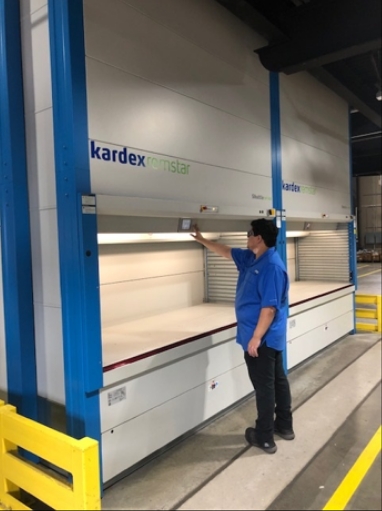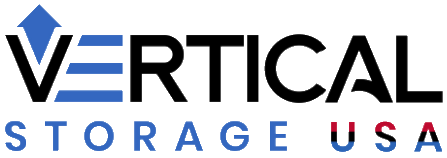Warehouse automation costs can range from around $50,000 for a small, targeted project (like a single automated storage system) to $5–15 million or more for a large, highly automated facility. Most mid-sized warehouses that add systems like vertical lift modules, carousels, and supporting software typically invest in the low six figures to a few million dollars, depending on scope.
At Vertical Storage USA, we help companies understand not just the price tag, but the payback period—often 2 to 5 years—by looking at labor savings, space recovery, and efficiency gains. This guide breaks down the initial investment, ongoing operational costs, and hidden factors that influence warehouse automation costs so you can plan your project with clear expectations.
Warehouse Automation Costs: Typical Ranges
Warehouse automation costs depend heavily on your size, throughput, and how far you want to go. As a general guideline:
Smaller targeted projects (partial automation):
Adding one or two vertical lift modules (VLMs), vertical carousels, or other point solutions usually falls in the $50,000–$500,000 range.Mid-sized, semi-automated warehouses:
Combining multiple automated storage systems with software, integration, and some conveyor or robotics can range from $500,000–$5 million.Large, highly automated facilities:
High-throughput operations with extensive conveyors, shuttle systems, robotics, and deep software integration may invest $5–15 million or more.
These figures include not just equipment, but also installation, integration, and facility modifications. The key is matching the level of automation to your current volume, growth plans, and labor challenges—not overspending for capacity you don’t need.
What Factors Influence the Cost of Warehouse Automation?
Several key factors influence the cost of warehouse automation:
Degree of automation
Are you adding a few automated storage systems (like VLMs or carousels), or building a near “dark warehouse” with extensive robotics, conveyors, and AS/RS? More automation = higher cost and complexity.Warehouse size and layout
Ceiling height, floor load capacity, column spacing, and existing racking all affect how much equipment you need and how easy it is to install.Throughput and order profile
The number of lines per order, picks per hour, and SKU count will drive how many machines you need and what technologies make sense.Type of equipment selected
Vertical lift modules, vertical carousels, horizontal carousels, conveyors, shuttles, and robotics each sit at different price points and support different use cases.Software and integration
Warehouse Management Systems (WMS), control software, and integrations with ERP/e-commerce platforms add cost—but they’re essential for smooth operation.Facility modifications
Electrical upgrades, floor reinforcement, fire protection, and layout changes can add 10–30% or more on top of hardware costs.Service, maintenance, and training
Ongoing service contracts, spare parts, and staff training will affect your total cost of ownership over the life of the system.
Understanding these factors makes it easier to compare solutions and build a realistic budget for your automation project.
What Are the Initial Costs of Warehouse Automation?
Warehouse automation requires a significant upfront investment. Understanding these costs will help you make informed decisions. We’ll break down the primary expenses you’ll encounter when you automate your warehouse.
Hardware: The Backbone of Automation
Warehouse automation can cost a lot upfront. However, the return on investment (ROI) can be worth it. The most substantial portion of your initial investment will go towards hardware. This includes robotic systems, conveyor belts, and automated storage and retrieval systems (AS/RS). Costs vary widely based on the scale and complexity of your operation.
Vertical Lift Modules (VLMs) and horizontal carousels are popular choices for optimizing vertical space. These systems can cost anywhere from $50,000 to $250,000 per unit (depending on size and features).
Software: The Brains of the Operation
Warehouse Management Systems (WMS) and control software coordinate your automated systems. While some hardware comes with built-in software, you may need to invest in additional programs for seamless integration. Top WMS solutions include Generix Solochain WMS, Shiphawk, Oracle SCM Cloud, Infor, and Odoo.
Installation and Integration: Putting It All Together
The expenses associated with installing and integrating your new systems are often overlooked. This process can cost anywhere from 20% to 40% of your hardware and software expenses. For a mid-sized warehouse, installation and integration might run between $100,000 to $500,000.
Facility Modifications: Preparing Your Space
Your existing warehouse may need modifications to accommodate new automation systems. This could include reinforcing floors, adjusting ceiling heights, or upgrading electrical systems. These costs can vary dramatically based on your current setup and the extent of changes required. Budget for at least 10% to 30% of your total hardware costs for facility modifications.
Long-Term Benefits vs. Upfront Costs
The upfront costs may seem high, but many businesses see a return on investment within 2 to 5 years through increased efficiency, reduced labor costs, and improved accuracy. As you plan your automation project, consider working with experienced providers to ensure you’re making the most cost-effective choices for your specific needs.
Now that we’ve covered the initial investment costs, let’s move on to the ongoing operational expenses you’ll need to consider when implementing warehouse automation.
What Are the Ongoing Costs of Warehouse Automation?
Maintenance and Repairs: Keeping Systems Running Smoothly
Regular maintenance forms a significant part of ongoing costs for automated warehouse systems. While specific maintenance costs can vary, it’s important to budget for both scheduled maintenance and potential emergency fixes. Some businesses opt for service contracts to manage these expenses.
Energy Consumption: Powering Automated Operations
Automated systems often increase energy usage in warehouses. The U.S. Energy Information Administration provides data on electricity consumption and expenditures for commercial buildings, including warehouses. To offset these expenses, companies should consider energy-efficient equipment and explore renewable energy options.
Software Updates and Licenses: Staying Current and Secure
Keeping warehouse management software up-to-date ensures optimal performance and security. Annual software licensing fees and periodic software upgrades require budgeting, with costs varying depending on system complexity and user numbers.
Training and Upskilling Staff: Investing in Human Capital
As automation technology evolves, ongoing staff training becomes essential. According to McKinsey, automation is expected to account for more than a third of capital spending in logistics and fulfillment, making it the largest fraction of any sector. Regular training ensures effective system operation, reduces errors, and improves overall efficiency.
While these ongoing costs may seem substantial, they contribute to the long-term success and efficiency of an automated warehouse. The next section will explore often overlooked expenses that businesses should consider when implementing warehouse automation.
What Hidden Costs Should You Consider in Warehouse Automation?
When implementing warehouse automation, several hidden costs and considerations can significantly impact your overall investment. These often-overlooked factors can make or break the success of your automation project.
Implementation Downtime
One of the most significant hidden costs is the potential loss of productivity during the implementation phase. Depending on the scale of your automation project, you might need to partially or fully shut down operations for days or even weeks. This downtime can lead to lost revenue and delayed orders. To minimize this impact, we recommend phasing your automation implementation or scheduling it during traditionally slower periods. Some companies opt for a parallel implementation (where they set up the new automated system alongside the existing one), gradually transitioning operations to minimize disruption.
Warehouse automation can boost business efficiency and cut costs by automating manual tasks.
Inventory Management Challenges
Transitioning to an automated system can lead to temporary inventory disruptions. You might face issues like misplaced items, inaccurate stock counts, or difficulties in locating specific products during the changeover. These disruptions can result in delayed orders, customer dissatisfaction, and potential revenue loss. To mitigate these risks, conduct a thorough inventory audit before implementation and consider using a hybrid system during the transition period. This approach allows you to gradually shift your inventory management processes while maintaining operational continuity.
Future-Proofing Your Investment
Scalability and future expansion costs are critical considerations often overlooked in initial planning. As your business grows, your automation system should be able to grow with it. However, expanding or upgrading an existing system can be costly and complex. When selecting an automation solution, prioritize modular systems that allow for easy expansion. Additionally, factor in potential future needs when designing your initial layout. This foresight can save you significant costs down the line.
A recent study by Logistics Management found that companies that invested in scalable automation solutions reported 30% lower expansion costs over a five-year period compared to those who opted for less flexible systems.
Cybersecurity: A Critical Investment
As warehouse operations become increasingly digitized, cybersecurity becomes an essential consideration. Automated systems are vulnerable to cyber attacks, which can lead to operational disruptions, data breaches, and financial losses. Investing in robust cybersecurity measures is essential but often overlooked in initial budgeting.
The global average cost of a data breach in 2024 is USD 4.88M, which is a 10% increase over the previous year and the highest total ever. This figure underscores the importance of allocating resources for ongoing cybersecurity measures, including regular security audits, employee training, and up-to-date security software.
Can Small Businesses Implement Warehouse Automation Cost-Effectively?
Yes—small businesses can absolutely implement warehouse automation cost-effectively when they start with focused, scalable projects instead of trying to automate everything at once.
Cost-effective strategies for smaller operations include:
Targeted pain points first
Automate the highest-labor, highest-error area (for example, small parts picking) with one or two vertical lift modules or carousels instead of automating the entire building.Modular, scalable systems
Choose equipment that can be expanded later—for example, adding more VLMs or carousels as volume grows.Using existing space better
By storing vertically and recovering up to 90% of floor space, small businesses can delay or avoid moving into a bigger, more expensive building.Phased implementation
Roll out automation in phases to spread the investment over time while learning what works best.
At Vertical Storage USA, we often work with smaller warehouses that start with a single automated storage system and then expand as they see results. This phased approach keeps warehouse automation costs aligned with actual growth and cash flow.
Final Thoughts
Warehouse automation costs include initial investments, ongoing expenses, and hidden factors. Companies must conduct a thorough cost-benefit analysis to make informed decisions and avoid unexpected financial burdens. The scalability of automation solutions and robust cybersecurity measures play vital roles in long-term success and protection against potential threats.
Despite the initial warehouse automation cost, increased productivity, reduced errors, and improved customer satisfaction make it a valuable investment for many businesses. Vertical Storage USA offers a range of automated storage and retrieval solutions to optimize warehouse efficiency. Our expert team can help you navigate the complexities of warehouse automation and choose the right solutions for your specific needs and budget.
Companies that carefully weigh the costs against potential benefits and partner with experienced providers can successfully implement warehouse automation. This implementation will allow businesses to gain a competitive edge in today’s fast-paced logistics landscape. The long-term benefits often outweigh the initial investment, with a positive return on investment typically realized within two to five years.





